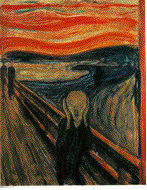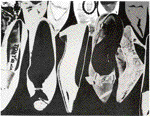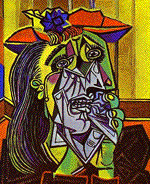"I shall consider human actions and desires in exactly the same manner, as though I were concerned with lines, planes, and solids"--
Baruch Spinoza, The Ethics
The noun affect entered the English language in the 14th century. Derived from the Latin word affectus, disposition, it is first recorded in Geoffrey Chaucer's Troylus and Cressida (OED). Affect is often, but not exclusively, used as a synonym for passion, sentiment, mood, feeling or emotion. Most discussion of affect in media theory and aesthetics revolves around questions of the production and transmission of affect. How do (and how should) artworks produce and transmit affect? What is the relationship between media and the production of affect? Philosophical and psychological explanations of the nature and function of affect are always intertwined with the answers media theorists offer to these questions. Because the breadth of these explanations makes a complete survey impossible, this article will focus on two especially influential traditions of understanding affect and then trace the media theories that draw from them.

The first tradition attempts to understand affect as embodied force that influences the mind. Aristotle's account of affect in the Rhetoric is characteristic. He argues that affect is "that which leads one's condition to become so transformed that his judgment is affected, and which is accompanied by pleasure and pain" (Aristotle, "Rhetoric" 6). Aristotle's affect is a force embodied through pleasure and pain that shifts our condition and our judgment. Rene Descartes offers a richer account of the way affect works as a bodily force. For Descartes, affects (or passions) are "the perceptions, feeling or emotions of the soul which we relate specially to it [the soul], and which are caused, maintained and fortified by some movement of the spirit" (Descartes, 21). The 'spirits' mentioned in this passage are "animal spirits," the material medium that Descartes believed allowed the body and the mind to communicate. The specific motions of this fluid determine the specific nature of the affect. For example, "Love is an emotion of the soul caused by the movement of the spirits which incites it to join itself willingly to objects which appear to it to be agreeable" (Descartes, 23).

Media theories that work from this understanding of affect usually focus on ways affect is produced through mimesis. In the Poetics, Aristotle argues that a perfect tragedy "should...imitate actions which excite pity and fear" (Aristotle, "Rhetoric" 2.13) The argument that affect is produced through mimesis has often been used as an explanation of music's ability to produce affect. In Plato's discussion of music in The Republic, he proposes that each mode of music is distinguished by its imitation of human action. For example, "that mode which would appropriately imitate the sounds and accents of a man who is courageous in warlike deeds and every violent works" is designed to "produce the finest imitation of the sounds of unfortunate and fortunate, moderate and courageous men" and thus inspire virtue (Plato, par. 399a-b). The contemporary philosopher Peter Kivy argues that this theory of music was interpreted by many to mean that "melodies have the power to arouse emotions in listeners by imitating or representing the manner in which they express them in speech and exclamations" (Kivy, 16)
Although many have taken issue with these arguments, two criticisms of the mimetic understanding of affect production are especially important. One, made by the 19th century music theorist, Eduard Hanslick, insists that the claim that music produces affect is philosophically incoherent. Hanslick argues that for an affect to be produced, there must be an object of attention. For example, when we are afraid, we are always afraid of something (the bear, the dark, the serial killer in the closet). Music cannot be a significant object for our affects, therefore it cannot produce any affects (Kivy, 26). The second criticism insists that art which exists to produce affect is "kitsch." In his essay Avant-Garde and Kitsch, Clement Greenberg compares two paintings, one by Illya Repin, one by Pablo Picasso to demonstrate his conception of Kitsch. He writes "Where Picasso paints cause, Repin paints effect. Repin predigests art for the spectator and spares him the effort, provides him with a shortcut to the pleasure of art that detours what is necessarily difficult in genuine art. Repin, or kitsch, is synthetic art" (Greenberg, 15) Kitsch produces affect without demanding any work by the viewer.
Hanslick and Greenberg's criticisms point towards another conceptualization of affect which insists on the interrelation of affect and cognition. Baruch Spinoza offers the foundational account of this tradition. In the Ethics, he defines affect as "the modifications of the body whereby the active power of the said body is increased or diminished, aided or constrained, and also the ideas of such modification" (Spinoza, 130). All human activity, including cognition, produces and is produced by affect. In Matter and Memory, Henri Bergson further links cognition and affect. He defines affect as "that part or aspect of the inside of our bodies which mix with the image of external bodies." This 'part or aspect' is necessarily produced by any perception, and therefore, for Bergson, "there is no perception without affection" (Bergson, 60). The German-Italian phenomenologist Franz Brentano argued that each cognitive action is constituted of a 'presentation", a judgment, and an emotion. He offers the example of hearing a sound, "obviously accompanied by not only by a presentation and a cognition of this act of hearing, but an emotion as well. It may be either pleasure, as when we hear a soft, pure young voice, or of displeasure, as when we hear the scratching of a violin badly played." (Bergson, 144) Brentano's argument that affect, like the rest of cognition, is always intentional shares significant form with Hanslick's argument against music's ability to produce affect.
William James' model of emotion offers an embodied account of affect that remains unified with cognition. In his article What Is An Emotion, James offers a good synopsis of his view "Common sense says, we lose our fortune, are sorry and weep; we meet a bear, are frightened and run; we are insulted by a rival, are angry and strike. The hypothesis here to be defended says that this order of sequence is incorrect, that the one mental state is not immediately induced by the other, that the bodily manifestations must be first interposed between, and that the more rational statement is that we feel sorry because we cry, angry because we strike, afraid because we tremble" (James, 13). For James, a perception immediately produces an affect within the body. Only later is the affect transformed into a recognizable emotion.
In What Is Philosophy, Felix Guattari and Gilles Deleuze use these conceptions of affect to develop their sense of the aesthetic. They argue that art is "a bloc of sensations, that is to say, a compound of percepts and affects" (Deleuze, 163).Here, affect is both embodied and bound up with consciousness. For the two, the artist can and must invent new affects, "A great novelist is above all an artist who invents unknown or unrecognized affects and brings them to light as the becoming of his characters" (174).
The conceptualization of affect as a fundamental part of human cognition is also integral to a series of theorists whose work focuses on the relationship between media and human behavior, most notably Marshall McLuhan. For McLuhan, the emergence of each media is marked by "the change of scale or pace or pattern that it introduces into human affairs'" (McLuhan, 8). These human affairs include most intimate affects. His account of the telephone's emotive impact is telling "Why should the phone create an intense feeling of loneliness? Why should we feel compelled to answer a ringing public phones when we know the call cannot concern us? Why does a phone ringing on the stage create instant tension? Why is that tension so very much less for an unanswered phone in a movie scene? The answer to all of these questions is simply that the phone is a participant form that demands a partner, with all the intensity of electric polarity" (268).

If McLuhan insists on the fundamental and instrumental role of media in changing human behaviors, Fredric Jameson insists that shifts in social arrangements produce changes in both media and affect. For example, he argues that a distinctive characteristic of the postmodern era (or late capitalism) is the 'waning of affect" (Jameson, 10). Jameson uses two images, Edward Munch's The Scream and Andy Warhol's Diamond Dust Shoes to demonstrate this 'waning'. Munch's image is an exemplary demonstration of the way affect functions in modernist images. Affect shapes representation itself -- the anguish of the screamer mutates the landscape. In the 'postmodern' Diamond Dust Shoes, human affect has waned. What remains is an endless field of cool commodities.
A number of contemporary thinkers have argued against Jameson's thesis, insisting that that the postmodern age is one of excess affect. In his essay The Autonomy of the Affect, Brian Massumi argues that ""Fredric Jameson notwithstanding, belief has waned for many, but not affect. If anything, our condition is characterized by a surfeit of it. The problem is that there is no cultural-theoretical vocabulary specific to affect" (Massumi, 27). Over the course of that essay Massumi develops this vocabulary, combining the work of thinkers inside the 'second' tradition of affect (especially Bergson, Deleuze, and Spinoza) to argue that affect is "a suspension of affect-reaction circuits and linear temporality in a sink of what might be called passion" (Massumi, 29). For Massumi, this 'state of suspension' is the rule; our world is saturated with affects. In the essay The Time of The Cinema. On the 'New World' and 'Cultural Exception', Bernard Stiegler offers an account of the way cinema produces this 'surfeit of affect' through the manipulation and reproduction of temporality. He writes that "because the flux of consciousness is a contraction of time, cinema can triggers this process of adoption in which my time, during the time of the film, becomes the time of an other and another time" (30). While watching the film, the temporal experience of the viewer is mapped onto the time of the film itself. Stiegler's worry is that this power to produce cinema remains in the hands of the few and powerful, leaving most as mere receptors of affect.
A more optimistic perspective is offered by Mark B.N Hansen in his essay, Affect as Medium, or the "Digital-facial-image. Hansen argues that affect can offer "an interface between the domain of information (the digital) and embodied human experience" (5). For Hansen, 'Digital-facial-images'" are the vessels for the production of this affect-medium. These digitally produced, often interactive images of human faces force the viewer to "recognize our intense desire to engage affectively with the 'virtual' at the same time as we confront the disconcerting possibility of its utter indifference to us "(10). This uncanny combination produces immediate embodied affect that links the human to the digital in a feedback loop.

Massumi's, Stiegler's, and Hansen's accounts demonstrate the significance of affect as a force in the contemporary media landscape. The density and volatility of affect production and transmission presents constant threat of danger and manipulation, but perhaps, as Hansen suggests, it also offers the promise of moving past old distinctions and creating new connections.
file:///Users/michelle/Desktop/keywords/html/images/affect-3.gif
Ben Shepard



